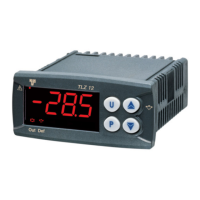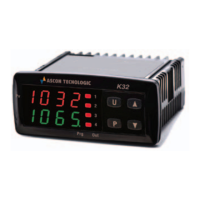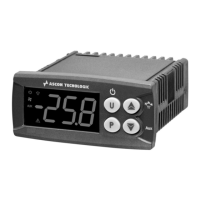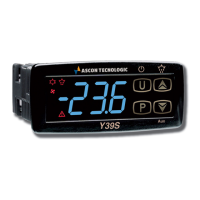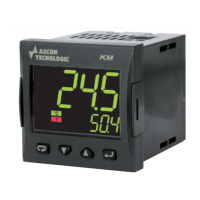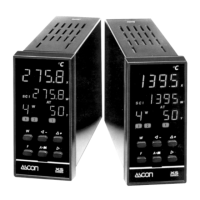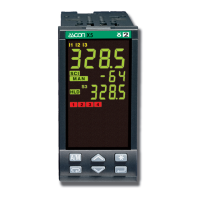To change the visibility of the parameter, press the key U: the led
SET will change status, indicating the accessibility level of the
parameter (on = parameter “visible”; off = parameter “hidden”).
The access procedure for “hidden” parameters allows the “PASS”
parameter to be checked and changed, and is useful therefore if
the password set has been forgotten.
2.5 - ACTIVE SET POINT SELECTION
The instrument allows up to 2 different regulation Set points to be
pre-set (“SP 1” and “SP 2”) and then to choose which one to
make active.
This function can be used if it is necessary to switch two different
function temperatures (e.g. day and night or positive and negative
etc).
The active set point can be selected:
- Using the parameter “SPAt”
- using the key U if the parameter "USrb" = 3.
- Using the key DOWN/AUX if the parameter "Fbd" = 3.
- Using the digital input if the parameter. “diF” = 8
(see par. 4.10 e 4.12)
The Set points "SP1" and "SP2" can be set with a value between
the programmed value in parameter. “SPLL” and the programmed
value in parameter “SPHL”.
Nota: in the examples that follow, the Set point is generally
indicated as "SP", how when operating the instrument will work
according to the Set point selected as active.
2.6 - ON / STAND-BY FUNCTION
The instrument, once powered up, can assume 2 different
conditions:
- ON : means that the controller uses the control functions.
- STAND-BY : means that the controller does not use any control
function and the display is turned off except for the green SET led.
If there is no power, and then power returns, the system always
sets itself in the condition it was in before the black-out.
The ON/Stand-by function can be selected:
- Using the key U if the parameter "USrb" = 4.
- Using the key DOWN/AUX if the parameter "Fbd" = 4.
- using the digital input if the parameter “diF” = 10
(see par. 4.10 e 4.12)
2.7 - TIME SETTING
When the instrument has an internal clock it is necessary to
programme it on the current time by using the parameter “StCL”
contained in the group “
]
CLO“.
The instrument has an internal quartz for the clock, however,
should the clock become inaccurate (especially over a long period)
it can be adjusted daily using the parameter “CLOF” contained in
the same group.
The working of the clock is guaranteed by an internal condenser for
a period of about 4 hours without any power to the instrument.
If the instrument should remain without power for a long period,
remember to check and if necessary re-programme the exact time.
3 - INFORMATION ON INSTALLATION AND USE
3.1 - PERMITTED USE
The instrument has been projected and manufactured as a
measuring and control device to be used according to EN61010-1
for the altitudes operation until 2000 ms.
The use of the instrument for applications not expressly permitted
by the above mentioned rule must adopt all the necessary
protective measures.
The instrument CANNOT be used in dangerous environments
(flammable or explosive) without adequate protection.
The installer must ensure that EMC rules are respected, also after
the instrument installation, if necessary using proper filters.
Whenever a failure or a malfunction of the device may cause
dangerous situations for persons, thing or animals, please
remember that the plant has to be equipped with additional devices
which will guarantee safety.
3.2 - MECHANICAL MOUNTING
The instrument, in case 33 x 75 mm, is designed for flush-in panel
mounting.
Make a hole 29 x 71 mm and insert the instrument, fixing it with the
provided special bracket.
We recommend that the gasket is mounted in order to obtain the
front protection degree as declared. Avoid placing the instrument in
environments with very high humidity levels or dirt that may create
condensation or introduction of conductive substances into the
instrument.
Ensure adequate ventilation to the instrument and avoid installation
in containers that house devices which may overheat or which may
cause the instrument to function at a higher temperature than the
one permitted and declared.
Connect the instrument as far away as possible from sources of
electromagnetic disturbances such as motors, power relays, relays,
solenoid valves, etc.
3.3 - ELECTRICAL CONNECTION
Carry out the electrical wiring by connecting only one wire to each
terminal, according to the following diagram, checking that the
power supply is the same as that indicated on the instrument and
that the load current absorption is no higher than the maximum
electricity current permitted.
As the instrument is built-in equipment with permanent connection
inside housing, it is not equipped with either switches or internal
devices to protect against overload of current: the installation will
include an overload protection and a two-phase circuit-breaker,
placed as near as possible to the instrument, and located in a
position that can easily be reached by the user and marked as
instrument disconnecting device which interrupts the power supply
to the equipment.
It is also recommended that the supply of all the electrical circuits
connected to the instrument must be protect properly, using
devices (ex. fuses) proportionate to the circulating currents.
It is strongly recommended that cables with proper insulation,
according to the working voltages and temperatures, be used.
Furthermore, the input cable of the probe has to be kept separate
from line voltage wiring. If the input cable of the probe is screened,
it has to be connected to the ground with only one side.
Whether the instrument is 12 V version it’s recommended to use an
external transformer TCTR, or with equivalent features, and to use
only one transformer for each instrument because there is no
insulation between supply and input.
We recommend that a check should be made that the parameters
are those desired and that the application functions correctly before
connecting the outputs to the actuators so as to avoid
malfunctioning that may cause irregularities in the plant that could
cause damage to people, things or animals.
Ascon Tecnologic S.r.l. and its legal representatives do not
assume any responsibility for any damage to people, things or
animals deriving from violation, wrong or improper use or in
any case not in compliance with the instrument’s features.
3.4 - ELECTRICAL WIRING DIAGRAM
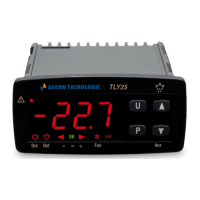
